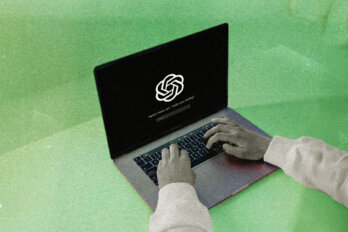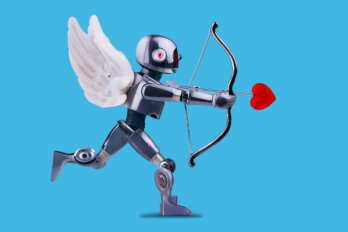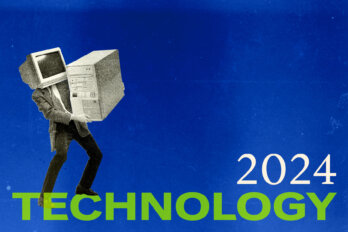Lying awake at three at night, I asked ChatGPT: “am I real?”
The question was not born out of curiosity or philosophical interest. It emerged in a fit of panic. I had been worrying about my future and the rapid changes that would soon be occurring—graduation, university, moving away from home. The slowly building fear of these coming changes eventually unfurled into full-blown anxiety—not just over my future but also over my identity and, eventually, over what identity itself might really mean.
As I spiralled, I wasn’t interested in dealing with, or even accepting, this uncertainty. I was only interested in a fast fix, pushing ChatGPT to respond to my anxieties. Within seconds, ChatGPT described a variety of philosophical perspectives on identity and existence—everything from Hume and Descartes to Heidegger and Nietzsche—summarizing each approach in a couple sentences.
I felt embarrassed that I had turned to a chatbot for help. Of course, reading the entirety of Discourse on Method at 3 a.m. was not an option, but why had I not chosen to read a short paper from an actual philosopher? Why not a five-minute YouTube video by a professor or other trained authority?
The answer, of course, was simple. These options required time and patience. They required me to feel my fear for a longer period of time. More than that, they required a form of critical thought that would involve facing some aspects of humanness—such as uncertainty, fear, and self-reflection—that, at this late hour, were rather unbearable.
For a very short moment, I felt relief—relief that there were possible answers to these great uncertainties, that there was something that could spew easy answers to difficult questions. But I hadn’t really learned anything. The true nature of these complex philosophical perspectives and their application to my life had not been revealed. Very quickly, my fears returned, because this uncertainty—over my future and who I was and wanted to be—hadn’t been mediated at all. The fast fix provided only temporary comfort, because it made it seem like my uncertainties might have some easy answers, the same way AI made it seem like this massive question did. But this sense of mediation was only temporary. Human pains are not technological.
I have observed this tendency—the need to instantaneously mediate, drown, and avoid psychic pains—in myself and nearly everyone around me. People have begun to rely on technological quick fixes to deal with every uncomfortable thought or feeling—the most prominent escape tool being social media (where the ability to scroll endlessly proves to be very successful in burying human discomfort).
I have come to believe that these quick fixes threaten our mental health, relationships, and creativity. This is because these shortcuts do not allow us to move through, accept, or understand our pains—they only bury them, isolate them, or delay them. So what can be done to counteract this insatiable need to bury our humanity under a pile of distractive media?
Studies have found that rates of teenage depression have spiked drastically since the early 2010s, coinciding with the popularization of smartphones. A 2019 study found that teenagers spending more than three hours per day on social media “may be at heightened risk for mental health problems,” including symptoms of depression and anxiety.
The link between poor mental health and social media use is often traced to comparisons of body types and unattainable lifestyles, as people tend to showcase only the most desirable and curated aspects of their lives. While this certainly plays a role—social media often excludes the more difficult, mundane, or unglamorous sides of daily life—I believe the harm runs even deeper.
The more time my friends, family, and I spend on social media, the more I notice a pattern: when stress, anxiety, or sadness arise, we don’t sit with those feelings—we smother them. The reflex isn’t to process or confront but to escape, to disappear into the infinite scroll of distraction. And the more we do it, the more automatic it becomes. Doomscrolling isn’t just a habit; it’s a coping mechanism.
Chasing this immediate relief has distorted our understanding of human pain. Discomfort, uncertainty, sadness, panic, and loneliness no longer feel like natural parts of life—they feel intolerable. Instead of sitting with these emotions, instead of working through them, we scroll. Not to unwind, not to relax, but to numb. And the more we numb ourselves, the more foreign and unmanageable our own feelings become. We don’t process them. We don’t even recognize them. We’ve lost the ability to be with ourselves.
The relentless pace of social media leaves little room for self-reflection or genuine reckoning with our own isolation. Art, on the other hand, offers what social media cannot. Reading, watching films, listening to music—these experiences slow us down, inviting us to sit with the discomfort of being human. They allow our pain, instead of numbing and burying it.
This is because art serves to fill the gaps within our experience—to put words or images or sounds to feelings which we cannot place on our own. During a period of fear and uncertainty over my future, I found great comfort in Samuel Beckett’s tragicomic Murphy and Virginia Woolf’s To the Lighthouse. Part of why that period was so difficult for me was that I could not quite place what was so wrong: why I felt such fear, why I felt such a sense of confusion. I felt isolated from myself, and the characters in both novels feel the same way. They, too, struggle with uncertainty, with purpose, with making sense of how to move through the world. The writers of these novels had words for these experiences, words which, at the time, I did not.
Art doesn’t just help us reconcile the fractures within ourselves. It also bridges the distances between us. It allows us, even if briefly, to step into another person’s experience. It doesn’t matter if the person is on the other side of the world, is of a different age, or is even from a different time period: we get a window into their world. In doing so, art fosters empathy. We begin to understand why people act the way they do, to see that their struggles and joys are not so different from our own. By engaging with stories, music, film—by immersing ourselves in genuine artistic expression—we reconnect not just with others but with our shared humanity.
For centuries, one of art’s greatest roles has been to cultivate empathy. Fiction, in particular, plays a crucial part: studies show that reading stories can enhance our social cognition, helping us better understand what others think and feel. It has also been linked to increased empathy. When we engage with art, we don’t just passively observe; we absorb perspectives, emotions, and experiences beyond our own. This deepened sense of connection can move us to act, to care, to help those in pain—something the numbing cycle of doomscrolling rarely inspires.
One could argue that social media also contains art and authentic human experiences. And while that’s true, simply encountering these moments isn’t enough to counteract the numbing effect of the doomscroll. Even when we stumble upon something meaningful—something that connects us to ourselves or others—it’s quickly swept away, buried under an endless stream of new content. Whatever resonance it had is fleeting, replaced almost instantly. Doomscrolling doesn’t create space for reflection, for sitting with an idea or feeling. It doesn’t offer the depth or immersion that true engagement with art provides—the kind that allows us to process, to understand, to feel.
I’m not suggesting social media is an all-destructive force that should be avoided at all costs. It has its benefits and is undeniably woven into our daily lives. But I do want to challenge its role as a quick fix for the discomforts of being human. When we use it to temporarily escape pain, we erode our ability to tolerate or understand it.
I’ve come to see AI in much the same way. Just as I believe social media shouldn’t be a shortcut to feeling, AI shouldn’t be a shortcut to thinking. The biggest questions we face don’t—and shouldn’t—have quick, easy answers. Art is one of the ways we engage with these questions, breaking them apart, rebuilding them, and deepening our understanding. These questions emerge from a distinctly human experience of the world, and so the search for answers must remain human as well.
Pain, uncertainty, wonder—these aren’t technological problems, and AI, incapable of true interpretation, cannot give voice to the complexity of human life. Only human-made art can.




